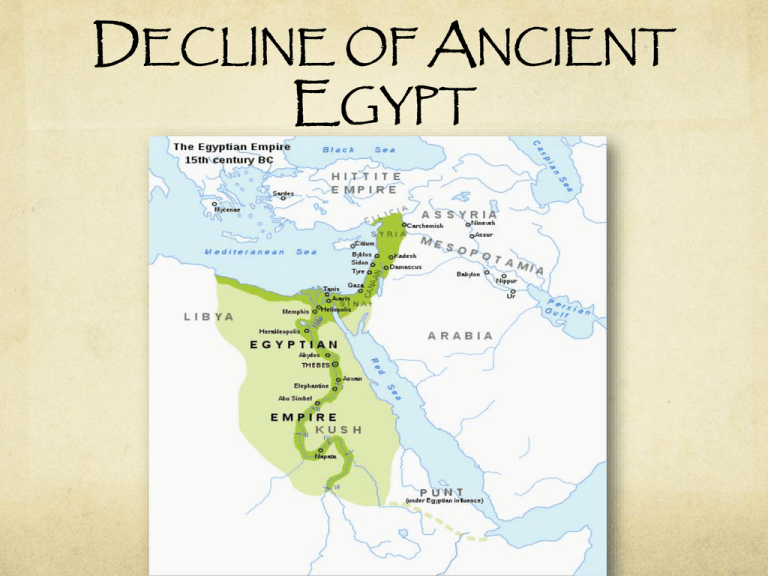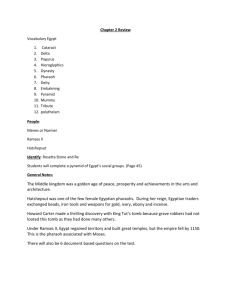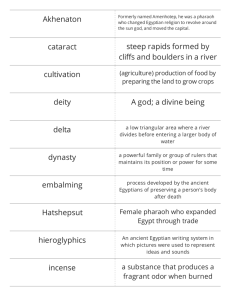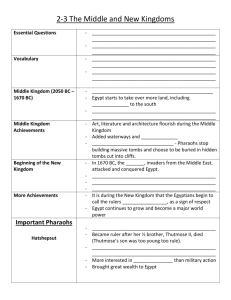End of Egypt - MStew
advertisement

DECLINE OF ANCIENT EGYPT New Kingdom unprecedented prosperity Securing borders/strengthening diplomatic ties Military campaigns waged under Tuthmosis I and his grandson Tuthmosis III extended influence of pharaohs into Syria and Nubia opening access to critical imports such as bronze and wood large-scale building campaign to promote the god Amun, in Karnak. Social Changes During the New Kingdom, society grew more fluid as trade and warfare increased Trade-new opportunities to merchant class Foreign conquests-riches to Egypt result: More business for artisans Hatshepsut female pharaoh Hatshepsut used propaganda to legitimize her claim to the throne. successful reign marked by trading expeditions to Punt, mortuary temple, a colossal obelisks and chapel at Karnak nephew-stepson Tuthmosis III sought to erase her legacy near the end of his reign, possibly in retaliation for usurping his throne. Queen Hatshepsut Married her half brother Thutmose II Ruled with Thutmose III, Thutmose II son by another wife Appointed herself pharaoh Disappeared when Thutmose III led a revolt to gain power Thutmose III Destroyed as much evidence as possible of his stepmother/ aunt Known as great military leader “Napoleon of Ancient Egypt” In his 54 years of rule, he captured over 350 cities Buried in the Valley of the Kings (KV 34) Amenhotep IV - Akhenaten Around 1350 BC - Amenhotep IV Akhenaten, believed obscure sun god Aten as the supreme deity attacked the power of the priest establishment. Moving capital to Amarna Ignored foreign affairs and absorbed himself in new religion and artistic style. After death, the cult of the Aten quickly abandoned subsequent pharaohs Tutankhamun, Ay, and Horemheb erased all mention of Akhenaten's heresy, (Amarna Period) Tutankhamun o Known as the “Boy King” o Married one of his half sisters o Helped to restore the Ancient Egyptian belief in polytheism o Took over the throne when he was only 9 o Died around the age of 19 due to a head injury o Buried in the Valley of the Kings Ramesses II 1279 BC - Ramesses II - built more temples, erect more statues and obelisks, and sire more children than any other pharaoh in history. bold military leader, led army against the Hittites - Battle of Kadesh after to stalemate, agreed to the first recorded peace treaty around 1258 BC After death no strong military power Egypt's wealth tempting target for invasion (Libyans and Sea Peoples) Egypt eventually lost control of Syria and Palestine. Valley of the Kings Used from the 18th Dynasty to 20th Dynasty Common burial ground for kings/ pharaohs Often robbed by common thieves Recent discoveries have occur in KV 5, this is Ramesses II tomb of his sons Mummification The preservation of the dead (wealthy citizens who could afford the pricy burial practice) Skilled embalmers removed vital organs, then dried and wrapped the body in strips of linen This process could take months to complete At first this was a privilege reserved for rulers and nobles. Eventually, ordinary Egyptians were able to mummify their dead (A) ANUBIS The priest in charge of the mummification wore the mask of Anubis (the god of mummification). (B) INCENSE A priest stands by, holding sweet-smelling incense. (C) WRAPPING THE BODY The body, or mummy, was wrapped in layers of linen before being placed in the coffin. (D) NATRON Natron, a kind of soda, was placed in the body to dry it out before it was wrapped in linen. (E) SOAKING THE BANDAGES Sometimes, linen strips were soaked in plaster so they would harden when dry. Third Intermediate Period Egypt's far-reaching prestige declined considerably south controlled by High Priests of Amun at Thebes, did not recognize new pharaoh linage Libyans in delta, increasing their autonomy Temple, cities and villages sacked by foreign invaders from north and east No central political or cultural center Persian ruler Mazaces handed Egypt over to Alexander the Great without resistance Ptolemaic Dynasty – Alexander the Great In 332 BC, Alexander the Great conquered Egypt with little resistance welcomed by the Egyptians administration established by Alexander's successors, the Ptolemies, based on Egyptian model in the new capital city, Alexandria city - power and prestige of Greek rule became a seat of learning and culture, centered of famous Library of Alexandria Lighthouse of Alexandria lit the way for the many ships which kept trade flowing through the city Ptolemaic Dynasty Continued Ptolemies made commerce and revenue-generating enterprises top priority – eg. papyrus manufacturing Greek culture did not replace native Egyptian culture -effort to secure the loyalty of populace. built new temples in Egyptian style, supported traditional cults, and portrayed themselves as pharaohs. Rome soon relied more heavily on imports of grain from Egypt –as a result - Romans took great interest Ptolemaic politics Roman Domination Egypt became a province of the Roman Empire in 30 BC following the defeat of Marc Antony and Ptolemaic Queen Cleopatra VII by Octavian (later Emperor Augustus) in the Battle of Actium. Egypt’s final Collapse of Power Romans relied heavily on grain shipments from Egypt resulted in harsh Roman rule of Egyptian people strictly enforced the collection of heavy taxes Alexandria City became increasingly important center on the trade route with the orient, as exotic luxuries were in high demand in Rome. Local administration became Roman in style and closed to native Egyptians Power of Egypt now solely in the hands of a Stronger Empire.





